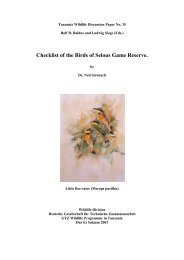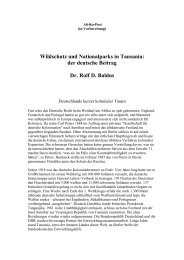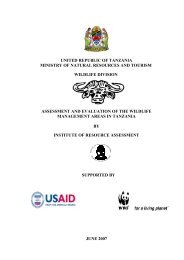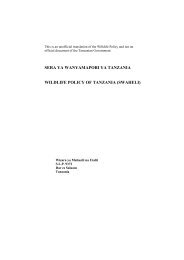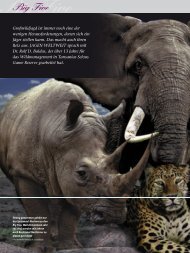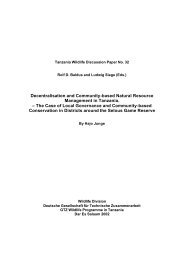African Indaba Articles - wildlife-baldus.com
African Indaba Articles - wildlife-baldus.com
African Indaba Articles - wildlife-baldus.com
Create successful ePaper yourself
Turn your PDF publications into a flip-book with our unique Google optimized e-Paper software.
http://www.iucn.org/themes/ssc/susg/. <strong>African</strong> <strong>Indaba</strong> thanks Mr. Robin Sharpe for the kind permission toreprint this article for our readers. If you want to read more about this topic you can also emailgerhard@muskwa.co.za for copies of some of the papers by Jon Hutton, Nigel Leader-Williams andGrahame Webb mentioned in the reference section of this textThe concept of sustainable use is now very widely interpreted. It is trumpeted too hard by some andattacked by others. On one side are those who hold that use of wild resources is OK because it can now beshown to be sustainable, and therefore (at the extreme) is justified as a right. On the other side are thosewho say, in effect, that "if we must have use then let's at least ensure that it is sustainable" and (at theextreme) "but no use is best".Both sides are missing the main point for conservation, which is that use of wild resources can motivateconservation. This point is crucial because (as Jon Hutton, Grahame Webb and others have written) use ofwild resources can be an especially important conservation incentive. Use tends to go with the flow of humansocial and economic pressures (and can provide human resources for conservation), whereas the protectand-reserveparadigm often runs against them (and can require resources).That isn't to say that protection is bad. Protection of particular species has been very valuable for showingthat society values them. Protection of areas has been crucial for holding back intensive cultivation and otherdevelopment. However, when human pressures really build up, protection alone can be<strong>com</strong>e inadequate orso expensive that an alternative approach could have conserved more biodiversity.The problem is that the interaction of "use is a right" and "if we must" attitudes creates problems forincentive-driven conservation. This is not just because a polarized dispute can give a concept a bad name. Itis also problematic because placating both attitudes can result in over-regulation. There may then be somany regulations on sustainable use that (i) some activities simply do not occur because they cannot provethey are sustainable or (ii) participants devote human and financial resources that could be channeled toconservation to merely meeting regulations.In effect, conservation through sustainable use be<strong>com</strong>es threatened by red tape that is aimed at makingthe use of resources sustainable. A background in a minority activity with great SU potential has taught mehow rules aimed at making falconry "safe" have resulted in raptor farming, which can (a) reduce incentivesand ability to conserve wild raptors and (b) raise other issues. It is vital to ensure that the "Addis AbabaPrinciples and Guidelines" adopted by the CBD are not used to justify unrealistic red tape. Any "rush forregulation", which may start as a laudable <strong>com</strong>promise, is sadly liable to be<strong>com</strong>e reinforced by protectioncampaigners who can target those breaching the rules and entrenched by administrators and technicianswho monitor use.What can be done? One way to reduce such a threat would be to reach general understanding of a needto reduce inefficiencies in conservation. That educational task will take time, but can be made easier by toolswith lots of leverage. A conceptual tool is to focus the thinking on economics: "how to get most conservationper user-dollar". Neither governments nor the (hu)man in the street may have much time for conservationphilosophy, but they all take an interest in economics. They understand money, and are increasinglyconcerned that red tape costs money.On this basis, we need to direct attention more towards the target (better conservation) than the process(sustainable use). Thus the process (Incentive Driven Conservation) may be best expressed for the public(and separated from state-based agri-environment payments) by the slogan "Conservation through Use".This can be an integrating theme, because it encourages extractive users to show how they are contributingto conservation, and also includes protection interests who add value through eco-tourism (as well aspractical benefits such as zoning). Protection and extraction organizations also need to cooperate to reducepolarization of public attitudes and hence pressures to over-regulate.A more tangible tool might be a landmark CBD conference on "Economics of Conservation through Use".In the longer term, help may <strong>com</strong>e from a software decision-support concept that is being developed inESUSG, to enable adaptive management and more flexible rules, while helping resource-users to benefitfinancially and being educational.There is other relevant information in the following papers:34



